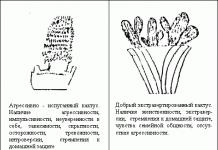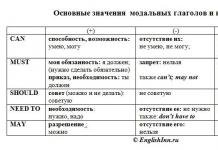English has been and remains the most popular foreign language studied at school. Exams in this subject have become more difficult since oral tests were introduced a few years ago. Will there be any changes to ticket content and order? conducting the Unified State Exam By English language in 2018? What can you do to effectively prepare for tests? How will this help in further study and work?
About the importance of the subject
Few people today need to explain how important knowledge of English is in modern world. This is the language of computer terms, the language of many business documents, and simply a convenient tool for international communication.
By 2020-2022, they plan to introduce it into the list of disciplines for which an exam is required. While it remains among the items of choice, one of the most popular in this category.
Those, Those who pass this subject with high results in 2018 can apply for admission to universities in very prestigious, popular specialties. And these are not only specialized foreign languages, diplomacy or Computer techologies. Good knowledge of English is rated in educational institutions in such areas as:
- regional studies;
- management;
- journalism;
- hotel business;
- philology;
- international relationships;
- world economy;
- sociology and a number of others.
Even in technical universities Sometimes an applicant is given a choice: to count points in physics or English.
In addition to actual knowledge of the subject, graduates will also be required to master the technical means with which audio recordings will be played during the oral part of the Unified State Exam. Of course, members of the commission will help if there are difficulties, but this will take time and will introduce unnecessary nervousness. During the exams, the classrooms will have computers equipped with headsets, necessary software, and microphones.
Unified State Examination dates in English in 2018
This exam is available ahead of schedule to graduates of previous years and some categories of current 11th graders who, for objective reasons, will not be able to come on the dates of the main tests.
Most of the high school students will appear for the main exam. It will take place June 11 (written), and two days were allotted for the oral format: June 14 and 16. In reserve for the written Unified State Exam June 26, orally - 27 . There's still a day June 29: General reserve for all items.
Finally, in September there will still be an opportunity to take the Unified State Exam for those graduates who planned to do this together with everyone else, but certain people prevented good reasons(illness, etc.).
What will be on the Unified State Examination tickets in English in 2018?
Since 2016, KIMs have introduced tasks not only for the written answer, but also for the oral part of the exam. Written and oral part separately, on different days.
Examiners need to test the level of knowledge of phonetics and grammar, the ability to speak fluent English, and not just read and translate. You even need to be able to listen: listening to a foreign language is not as easy as it seems.
In the written exam, which lasts 180 minutes, you will have to complete 40 tasks.. Such as:
- listening, that is, listening to a prepared text (a maximum of 20 primary points are given for it);
- reading (plus 20 points);
- for knowledge of vocabulary and grammar of the language, examiners have the right to add up to 20 points;
- Finally, for fluency in written language there is a chance to get the remaining 20 points.
Only 15 minutes are allotted for the oral exam, during which time 4 tasks are completed. This is a description of the pictures and answers to questions. The maximum score for this “semi-exam” is 20 points.
Along with the written test, there are 44 tasks of different difficulty levels and 100 maximum possible points.
What's in the oral part of the test?
The oral “portion” of tasks is otherwise called speaking, although not all of them consist of conversation. It is important to understand spoken language, conduct dialogue and demonstrate your public speaking skills in a foreign language.
Testing takes place either in special language laboratories or in computer classes, where the equipment is equipped with a special headset. In 15 minutes you need to cope with several tasks.
First, each graduate will be offered a short text. You can quickly skim through it (in a minute and a half) and then read it out loud.
Then, based on a fragment of text, you will need to formulate five questions. Again there will be 1.5 minutes to read the passage, and then you will have to quickly voice all 5 questions, only 20 seconds are given for each.
The next item in the “program” is a description of the photograph. One of the five proposed is selected, the examinee studies it (in the same minute and a half), and then states what he sees in two minutes. To help students in KIMs, a presentation plan will be given.
The last thing to do is compare the two pictures. Find similarities and differences in 1.5 minutes and briefly, in 2 minutes, tell the commission about them.
Features of the written part of KIMs
In the written, as well as in the oral part of KIMs, in 2018 there are no new topics or tasks provided. The 40 tasks in this section of the Unified State Exam are divided into 4 groups:
- Questions 1 to 9 are devoted to listening.
- Students demonstrate the ability to read correctly, with correct intonation, and clearly thanks to questions 10-18.
- The next ten tasks (19-38) are the actual letter.
- The examination committee checks knowledge in the field of vocabulary and grammar using questions 39-40.
All together you are given 3 hours.
Tests in the form that were before are no longer available. Although there are a number of questions on the tickets, the answer to which must be extremely brief: a word, letter or number.
Other tasks (they are located in the final part of the KIMs) require more detailed answers. There are also questions of increased complexity, they are based on the student’s full understanding of the text. The most difficult task is also task number 40 (in the “Writing” block): it involves writing an essay, short, but not descriptive, but with analysis and reflection.
Translation of Unified State Exam scores in English in 2018
As stated above, the highest score for both parts of the exam will be 100 points. When converted to commonly used estimates, the result will look like this:
- If you score up to 21 points, the exam is considered failed - this is “ deuce».
- From 22 to 58 points translated into a five-point system are equivalent to “ troika».
- Those who score from 59 to 83 points receive “ four».
- The exam is considered passed " five”, if the graduate scored a total of 84 points or more.
Those who cross the threshold of academic failure by earning 22 points will be issued a certificate. But to receive higher education such a result is not enough. Exactly how much is needed to get into the desired specialty at the chosen institution, you definitely need to find out in advance on the websites of these universities.
The experience of previous years suggests that even 45 points give only a ghostly chance to enter the ranks of students at “average” universities, and then, most likely, on a paid basis. And those who want to study in the capital, and even on a budget basis, need to collect at least 85 points for the Unified State Exam in English.
Preparation for the Unified State Exam in English in 2018
Quite a lot of high school students study in clubs, schools, and English language studios. When professionals work there, the level of training is usually quite high. There are elective classes in schools.
Other students choose self-study or tutoring. They have at their disposal demo versions of the Unified State Exam in English 2018, as well as versions of tasks from previous years with ready-made correct answers. In order to consolidate knowledge for successful completion written section The Unified State Examination can be a very good help. In any case, the language requires systematic study; one-time actions will not help here.
It is very important to listen to competent oral speech: audiobooks, lesson recordings, songs, poems in English. You can turn to classical or children's English literature, to films. In such a living form, the language is perceived more emotionally, in addition, situational memory and associations are triggered, which helps memorization.
But it’s not enough to recognize speech by ear; for many, the stumbling block becomes correct pronunciation. That is why it is extremely useful to study in pairs or in a small group. We rarely notice our flaws in speech, but a look and auditory control from the outside will be very useful. If someone in the family speaks the language, you can practice speaking with them in English about the simplest everyday things for at least a month before the exam. This is an excellent workout, besides, fear disappears, you become more free in communication, which is extremely important for your psychological mood.
English is the most popular of the languages. Today, without knowledge of a foreign language, it is difficult to achieve career heights in almost any profession, so a significant number of humanitarian universities require them to present an appropriate certificate. The English exam is chosen by students who plan to devote their lives to linguistics, teaching, technical and literary translation, diplomacy and international relations.
IN last years exam in foreign languages is becoming more and more difficult for graduates - now they are required not only to know the basic rules and language norms, but also to have significant speaking skills, because the oral part has been added to the Unified State Examination. Successfully passing the exam will require months of persistent and systematic independent work, and maybe even the help of a tutor. Another important point is awareness of possible innovations. Let's figure out how this exam will go in 2018!
Demo version of the Unified State Exam-2018
Unified State Examination dates in English
The approved schedule for the all-Russian examination will be published in January 2018. But today you can find out the approximate periods for conducting the Unified State Examination, designated by Rosobrnadzor:
- from the second half of March to mid-April 2018 years will pass early examination. The starting date is stated to be March 22. Let us remind you that not all schoolchildren can take the Unified State Exam early. These graduates include those who graduated from school before 2017/2018 school year, underachieving students from previous years without a certificate, as well as evening school students. Those who decided not to enroll in a university, but go to the university, can also take the test ahead of schedule. foreign universities, children leaving to live abroad, or those who came to study in Russia from abroad. An exception is made for children leaving for sports, cultural or scientific competitions and competitions, as well as for schoolchildren who are prescribed medical or rehabilitation procedures during the main testing;
- With last days May and until the beginning of June 2018, the main period of the Unified State Exam. Most likely, the first exams will begin on May 28, 2018;
- The start of the additional period of the Unified State Exam is announced on September 4, 2018. Additional examinations will take place during the first half of September.
How did past graduates pass English?
The popularity of the English language among future students of Russian universities is confirmed by official statistics - about 9% of all graduates (which is about 64.5 thousand schoolchildren in 2017) choose the Unified State Exam in this foreign language. In 2017, the proportion of graduates who were unable to score even the required minimum of 22 points decreased significantly.
The percentage of such failing eleventh graders in recent years has fluctuated between 1.8-3.3%, which looks very optimistic in comparison with other exams. Average score which is demonstrated Russian schoolchildren when passing English, it is equal to 64.8-65.1 points, which is approximately equal to the “four” mark. This is significantly higher than the results of other Unified State Examinations show.
 According to statistics, English is one of the easiest exams
According to statistics, English is one of the easiest exams Innovations in the Unified State Examination in English
Specialists from FIPI did not make any significant changes to the 2018 materials. The only innovation is that in English KIMs, the criteria-based approaches to assessing assignments numbered 39-40 have been clarified.
Contents of the English language ticket
The main purpose of the all-Russian examination in English is to check the level of mastery of a foreign language. The primary goal of the commission is to determine how free the student feels in various types language activities, which include listening, reading, writing and speaking. High school students will have to show their mastery skills lexical units, morphological forms and syntactic structures. The exam card itself is divided into two parts:
- written - within 180 minutes, students will have to solve 40 tasks. In this part of the exam, you need to pass listening (worth 20 primary points, which is 20% of all exam points), demonstrate reading skills (another 20 primary points), convince the commission of your knowledge of grammar and vocabulary (20 primary points), and show your level of written language proficiency (20 primary points);
- oral - within 15 minutes, students will have to solve 4 more tasks. They will have to answer questions and describe the pictures. This part is worth another 20 raw points (or 20% of the total exam points).
In total, graduates will have to cope with 44 tasks of basic, advanced and high levels of complexity, which in total give 100 points.
Written part of KIMs
Structurally, KIMs in English are presented in several main sections:
- Listening assessment, aimed at identifying how well the student understands the text being listened to. This task is allotted 30 minutes of exam time, during which the student must complete the following tasks:
- 1 – identifying the correspondence of statements and statements made in the recording. Students are asked to evaluate 6 statements, comparing them with 7 proposed answer statements, one of which is incorrect. The student is given 20 seconds to read the answer statements, then the audio recording will be played 2 times. After this, the student must mark the correct answers on the exam form;
- 2 – assessment of the correctness of judgments, which must be made after listening to an audio recording in dialogue form. The student is required to enter only the words “true”, “false” or “not stated”;
- from 3 to 9 – an audio task in the form of a short interview, after listening to which the student will need to choose the correct answer from the options presented on the form. Most often, the task is presented in the form of a question that needs to be answered, or an unfinished sentence that needs to be supplemented with the correct words.
- Reading aimed at checking the understanding of structural and semantic relationships in the proposed text. The student will receive 30 minutes, during which he must complete the following tasks:
- 10 – introduction to the family short texts and identifying the correspondence of the information presented with 8 headings, among which one option will be incorrect;
- 11 – working with text that has missing parts. There will be 6 such gaps in total. They need to be filled in by choosing words from the seven proposed options;
- from 12 to 18 – familiarization with an artistic or journalistic fragment, to which are attached interrogative sentences and statements with missing words. You will need to choose the correct answer or complete the phrase.
- Grammar and vocabulary - this part of the Unified State Exam will check how well the student operates with these language skills. This part of the ticket is considered the most difficult, because this is where students lose the most points. You will be given 40 minutes to work with this part of the ticket, during which you will have to solve the following tasks:
- from 19 to 25 – familiarization with several fragments of text in which words or phrases will be missing. The blanks will need to be filled in based on the answers, which must first be converted;
- from 26 to 31 – exercises testing word formation skills. The student is asked to read the text with missing pieces to determine which parts of speech are missing. To write down the correct answer, the missing word will need to be transformed (for example, turning a noun into an adjective);
- from 32 to 38 – vocabulary exercises that involve working with text fragments in which words are missing. Options for the correct answers are offered in the KIM form, so you just have to make the right choice.
- Writing – This part of the ticket will test your ability to create different types of written texts. You are given 80 minutes to complete the tasks, during which you need to complete the following exercises:
- 39 – the student will need to write a letter of a personal nature, keeping it to 100-140 words (it is proposed to complete the task in 20 minutes);
- 40 – writing an essay (200-250 words). Focus on the plan and topic proposed in the KIMs. In this task you will need to write a short introduction to the problem, express your opinion on this issue, support it with argumentation and draw a conclusion. You should allow approximately 60 minutes to complete this task.
 This Unified State Exam will require not only knowledge of the rules, but also language skills
This Unified State Exam will require not only knowledge of the rules, but also language skills Oral part of the exam
In this part of the exam, the commission will evaluate the student’s speech skills. A separate day will be allocated for this test. Each student will receive 15 minutes to complete the following types of tasks:
- Reading aloud a short text. For 1.5 minutes, the student has the opportunity to read the text to himself and then speak it out loud;
- Formulation of five questions based on a fragment of text. Most often this is an advertising message. The student will have 1.5 minutes to read the text, and then another 20 seconds to voice each question;
- Description of the photograph. Students are given a choice of five photos, among which they need to take one and describe it according to the plan proposed in KIMs. 1.5 minutes will be allotted for preparation, and then within 2 minutes you will need to express in your own words what you see in the picture;
- Comparison of two photographs. The student will have to identify similarities and differences between two pictures in 1.5 minutes, and then tell them to the commission in 2 minutes.
Examination procedure
The examination is regulated by strict standards. Firstly, in Unified State Exam time It will be impossible to use smartphones, video and audio equipment, smart watches and reference materials. Secondly, you should not look at someone else’s answer sheet, talk to other exam participants, or leave the classroom without an observer - this will be a reason for the cancellation of your work. Remember that in 2018, 100% of exam classrooms will be equipped with online surveillance systems.
Each classroom allocated for the written part of the examination will be equipped with technical means for playing audio recordings during listening. Classrooms for conducting the oral part of the Unified State Exam will be equipped with computers with headsets, microphones and appropriate software for recording answers.
How do exam scores translate into grades for a certificate?
Points for work affect the certificate and are easily transferred to the usual school system:
- 0-21 points correspond to the “two” level;
- 22-58 points indicate satisfactory preparation and are equal to a “three”;
- 59-83 points allow you to get a “B”;
- 84 points and above tell us that the student knows the subject “excellent”.
The minimum score that you need to score to receive a certificate is 22. However, it is worth remembering that to enter an “average” university you need to score at least 45 points, and in this case we are not talking about budget places. Educational establishments capitals usually accept schoolchildren on a budget who have managed to score 86 points or higher in English.
Preparation for the Unified State Exam in English
To pass the English language test, you will have to spend a lot of time preparing. Try to wisely distribute the time remaining before the exam to repeat school course and work on demo versions of CMMs. Their solution will help you understand the structure of the exam - you must agree that if you see a ticket for the Unified State Exam for the first time, you will probably get nervous. And this, in turn, will lead to a lot of small annoying mistakes. Official CMMs can be downloaded on our website simply by using the link at the beginning of the article.
 When preparing for the Unified State Exam, not only textbooks, but also audiobooks will help you!
When preparing for the Unified State Exam, not only textbooks, but also audiobooks will help you! Don’t forget about preparing for listening, because not every teacher at school devotes enough time in class to teach students to perceive foreign speech by ear. Audio books, songs by your favorite artists, films or television series in English will come to your aid. Watch at least a couple of episodes of an interesting TV series or movie a day, and listen to a book on the way to school. After a few months of such training, you will be able to distinguish words and learn to understand the meaning of the text by ear.
A frequent problem is also the inability to speak - if in vocabulary, grammar and writing the majority of children who have chosen a foreign language for themselves quality of the Unified State Exam demonstrates good results, the oral part causes certain difficulties. You can practice this skill in a fairly simple way - constantly playing small dialogues with everyday situations in your head, or describing objects, people and buildings that you see while going to school or shopping at the supermarket.
Writing an essay also requires special preparation. Hone your mini-essay writing skills using previous years' papers. Each new essay will help you better formulate your thoughts and present arguments in favor of your point of view. When writing an essay, keep these tips in mind:
- do not choose the first topic that comes to you - it is better to think about which one will be closer to you and will not require significant effort for argumentation. Part of the points in this task are awarded specifically for understanding the subject of discussion. If a committee member notices that you do not understand what you are writing about, the assignment will be given a zero;

Demo version of the Unified State Exam 2018 in English and others from FIPI, approved
Explanations for the demo version of the control measurement materials of the 2018 Unified State Exam in ENGLISH
When familiarizing yourself with the demo version of the control measuring instruments Unified State Exam materials 2018 Please note that the activities included do not reflect all of the content issues that will be tested using the 2018 CMM options.
A complete list of questions that can be controlled at the 2018 Unified State Exam is given in the codifier of content elements and requirements for the level of graduates’ training educational organizations to carry out a unified state exam 2018 in English.
Changes in the 2018 Unified State Exam in foreign languages:
There are no changes in structure or content. The criteria for assessing the completion of tasks 39 and 40 have been clarified.The work consists of four sections: listening, reading, grammar and vocabulary, writing.
Section 1 (“Listening”) contains 9 tasks. The recommended time to complete the tasks in section 1 is 30 minutes.
Section 2 (Reading) contains 9 tasks. The recommended time to complete the tasks in section 2 is 30 minutes.
Section 3 (“Grammar and Vocabulary”) contains 20 tasks. The recommended time to complete the tasks in section 3 is 40 minutes.
Section 4 ("Letter") consists of 2 tasks. The recommended time to complete the tasks in this section of the work is 80 minutes.
Purpose demo version is to enable any USE participant and the general public to get an idea of the structure of future CMMs, the number of tasks, their form and level of complexity. The given criteria for assessing the completion of tasks with a detailed answer, included in this option, give an idea of the requirements for the completeness and correctness of recording a detailed answer.
This information will allow graduates to develop a strategy for preparing for the Unified State Exam.
The English language examination paper consists of four sections (listening, reading, grammar and vocabulary, writing), including 40 tasks.
For execution exam paper 3 hours (180 minutes) are allotted.
Answers to tasks 3-9, 12-18 and 32-38 are written as one number, which corresponds to the number of the correct answer. Write this figure down on answer form No. 1.
 Section 4 (“Writing”) consists of 2 tasks (39 and 40) and is a short written work (writing a personal letter and written statement with elements of reasoning). In answer form No. 2, indicate the task number and write down the answer to it.
Section 4 (“Writing”) consists of 2 tasks (39 and 40) and is a short written work (writing a personal letter and written statement with elements of reasoning). In answer form No. 2, indicate the task number and write down the answer to it.
We wish you success!
Specification
control measuring materials
to be held in 2018
unified state exam
in FOREIGN LANGUAGES
1. Purpose of the examination paper
Tests measuring materials make it possible to establish the level of mastery by graduates of the Federal component of the state educational standard basic general and secondary (complete) general education.
The results of the unified state exam in a foreign language are generally recognized educational institutions, in which they are implemented educational programs secondary (complete) general education, as the results of state (final) certification, and by educational institutions of secondary vocational education and educational institutions of higher professional education - as results entrance examinations in a foreign language.
2. Documents defining the content of the examination paper
1. Federal component of state standards of basic general and secondary (complete) general education, basic and profile level (Order of the Ministry of Education of Russia dated March 5, 2004 No. 1089).
2. Sample programs in foreign languages // New state standards in foreign languages. Grades 2-11 / Education in documents and comments. M.: AST: Astrel, 2004.
3. Programs educational institutions. English for grades 10-11 schools with in-depth study foreign languages. M.: Education, 2003.
4. Programs for general education institutions. German language for secondary schools with in-depth study German language. M.: Education: MARCH, 2004.
5. Programs of general education institutions. French for grades 1-11 in schools with in-depth study of foreign languages. M.: Education, 2001.
6. Programs of general education institutions. Spanish for grades 5-11 in schools with in-depth study of foreign languages. M.: Education, 2005.
When developing CMMs, the following are also taken into account:
7. Common European Framework of Reference for Languages: Learning, teaching, assessment. MSLU, 2003.
3. Approaches to selecting content and developing the structure of the Unified State Exam KIM
The purpose of the unified state exam in a foreign language is to determine the level of foreign language communicative competence of the examinee. The main attention is paid to speech competence, i.e. communication skills in different types of speech activity: listening, reading, writing, as well as language competence, i.e. language knowledge and skills. Sociocultural knowledge and skills are tested indirectly in the “Listening” and “Reading” sections and are one of the objects of measurement in the “Writing” section; Compensatory skills are tested indirectly in the “Writing” section.
Consequently, the Unified State Exam KIM in foreign languages contains sections “Listening”, “Reading”, “Grammar and Vocabulary” and “Writing”. It should be borne in mind that although the sections “Listening”, “Reading” and “Writing” have skills in the corresponding types of speech activity as objects of control, these skills are provided by the necessary level of development of the language competence of the examinees. Successful completion of tasks for the control of receptive types of speech activity is ensured by knowledge of lexical units, morphological forms and syntactic structures and the skills of their recognition/recognition. The tasks in the “Writing” section require the examinee, in addition to this knowledge, to have the skills to operate lexical units and grammatical structures in a communicatively meaningful context. Spelling skills are the object of control in tasks B4-B16 of the “Grammar and Vocabulary” section, as well as tasks C1, C2 of the “Writing” section.
4. Structure of KIM Unified State Exam
The examination paper contains sections “Listening”, “Reading”, “Grammar and Vocabulary” and “Writing”.
To differentiate examinees by levels of foreign language proficiency within the limits formulated in the Federal component state standard general education in foreign languages, all sections include, along with basic level tasks, tasks of higher difficulty levels.
The level of difficulty of tasks is determined by the levels of complexity of the language material and skills being tested, as well as the type of task.
The foreign language work includes 28 tasks with a choice of answers from three or four proposed ones, 16 open-type tasks with a short answer, including matching tasks, and 2 open-type tasks with a detailed answer.
Basic, advanced and high levels of complexity of Unified State Examination tasks correlate with the levels of foreign language proficiency defined in documents of the Council of Europe 1 as follows:
- Basic level - A2+ 2
- Advanced level - B1
- High level - B2
1 Common European Framework of Reference for Languages: Learning, Teaching, Assessment. MSLU, 2003.
2 Since the entire possible range of levels of foreign language proficiency is presented in the Council of Europe document by only six levels, it is obvious that within each of them certain sublevels can be distinguished. The designation of the basic level of the Unified State Examination as A2+ means that from the description of level A2, to prepare tasks at the basic level, developers are guided by descriptors that lie closer to level B1, and not to level A1.
............................
Many graduates who plan to take the test in 2018 year of the Unified State Exam in English, have a huge number of questions related to points, assignments, and time to complete them.
The Unified State Examination in English will be a graduation school exam, the writing of which is available to everyone. It is the USE indicators that will act as the state exam when entering a university. At the moment, it is not necessary to take it, but if after graduation you want to enroll in a specialized university, then you will have to take it.
The structure of the Unified State Examination in English is very similar to international exam FCE, which is carried out in most European countries, to determine the level of development of the knowledge base on the subject. To pass, you must get the Upper-Intermediate mark (above average), which is not an easy task.
It is recommended to start preparing for the exam from the beginning of 10th grade. Only in this way, by gradually repeating all the material covered, will the student be able to master the knowledge in which there was a gap and fully prepare for the Unified State Exam in English in 2018. Of course, this process may take less time, but only if the student has high level knowledge, and always tries to achieve perfection.
The exam consists of two parts: oral and written, which are held on different days. First, graduates of 2017-2018 take a written block, which includes listening, reading, writing, speaking, as well as checking grammar and vocabulary. In total you need to complete 40 tasks in 3 hours. 80 is the maximum score you can get.
The second block - oral - is taken at the request of the student, and is aimed at improving the finished result. You are given only 15 minutes to complete it, during which you need to solve 4 additional tasks. Thus, you can improve your English language score by 20 points.
Any teacher will insist on attending both parts of the exam, because even if the student fails the second part, the student will not worsen his result for the written unit, but will have a chance to improve it.
There will be no changes to the Unified State Exam in English in 2018, so there is no reason to worry.
Demo version of the 2018 exam
The demo version of the Unified State Exam in English 2018, which includes changes and additions that are relevant for this year, will help you understand the structure of the exam and the requirements.
Download:
ege-2018-ang-demo.zip(23 Mb).
Inside the archive are demo versions of the written and oral parts, an mp3 listening file, a codifier and a specification.
How the exam works
The Unified State Exam in English has a very specific structure; the CMM makes it possible to quickly check the level of knowledge and skills according to basic parameters. Exam structure:
- Listening includes 3 audio fragments, which are connected into one tape. Having turned it on, the teacher does not have the right to pause or stop. There is a short pause between fragments, during which students must write the correct answers on the form.
- Reading. Half an hour and 9 tasks are allotted to complete this section. Among the main ones is to read short texts and connect them with suitable names, of which there will be 1 more.
Tip: most often it is in the first sentence that it is displayed main meaning test text, and then only clarifying details and little things that are not useful are given. As for the questions about the meaning of the text read, they go in the same order as the chronology of the story. This can also be tracked in FIPI tasks, which are freely available on the Internet. - Vocabulary and grammar are designed to assess the number of words learned, and the ability to form correct constructions from them, using right time and preposition.
Among the main tasks may be: enter the right word, or present it in a certain time, adding an ending, or raising it to the desired form. - The written part consists of two tasks, which take 80 minutes to complete. The first involves a letter from a friend with a series of questions to which the student must write an answer.
The second task is writing an essay in English. A controversial judgment is given as a topic, and the student must express an opinion on this matter and explain his point of view. Only full disclosure of his thoughts and feelings will probably give the highest score. We advise you not to deviate from the stated length of presentation of 200-250 characters. A demo version will help you practice writing, with the help of which your preparation will go well. You can also download a collection of essays, in which you will find many examples of correctly written works. - Oral speech. The test takes place in front of a computer screen using a headset. The monitor shows the time countdown; in total, 15 minutes are given for 4 tasks.
Having completed all the blocks, the student can receive a maximum score when passing the unified state exam. For each individual task, a student in the class receives certain points, which are then summed up.
The minimum passing score this year is 22, and the maximum is 100. After receiving the result, according to certain new criteria, it is transferred to the standard five-point system, which is more familiar:
- A score of 0-21 corresponds to a score of 2, and means that the test in the subject has failed.
- 22-58 points is a score of 3.
- 59-83 points means good result, and a rating of 4.
- Scoring 84-100 points means that you passed the exam perfectly, grade 5.
Usually, the results can be found out within 14 days after passing, when both blocks have been passed. But, in some cases, estimates can be found out within 12 days. To do this, you need to visit the official website and find your last name. The mandatory issuance of paper certificates has been abolished, and they can now be viewed exclusively on the Internet.
the date of the
At the moment, it is a little early to talk about the date of the exam; there is only preliminary information that may still change. The final decision will be announced at the beginning of 2018, but according to the latest information it is:
- At the end of March (preliminarily on the 22nd) an early examination will be held. Graduates of previous years, evening school students, future army personnel, foreigners, or those leaving the country are allowed to take this version. In this case, it is important to have a demonstration document confirming one of the above facts.
- The main period will start on May 28. All interested students can take part in it.
- The additional period is designated from September 4.
How to prepare for the Unified State Exam
The very essence and structure of the Unified State Exam have not been affected by the changes, which means that preparation for it remains as thorough and difficult as in previous years. In order to achieve the optimal option, you need to initially correctly distribute your time in order to have time to repeat all the material before the decisive day. There is no need to combine different types activities, and not focus on just one. For example, you need to spend time reading and speaking, and not just practicing writing test assignments.
The FIPI website will be an excellent assistant in preparing for the Unified State Exam. The site has an extensive bank of tasks of varying difficulty. The FIPI task bank allows you to significantly improve your skills by simply completing number by number. By constantly training on such a simulator and studying the tasks of 2018, you will certainly achieve good results.
In addition, try to surround yourself with English-language sources of information as much as possible: watch films in a foreign language, read books, listen to the lyrics of your favorite songs.
There are documents that regulate the structure and content of CMMs - codifiers and specifications. A complete list of questions that can be monitored at the 2018 Unified State Exam is given in the codifier of content elements and requirements for the level of training of graduates of educational organizations for the 2018 Unified State Exam in English.
Demo version of the Unified State Exam 2018 in English
| Assignment option + written answers | variant + answer |
| Oral part - demo version | Option+criteria |
| Codifier | download |
| Specification | download |
| Listening | audio |
Changes to KIM 201 There are no 8 years of English compared to 2017. The criteria for assessing the completion of tasks 39 and 40 of the “Writing” section in the written part of the exam have been clarified.
Minimum score Unified State Exam 2017 in English - 22
Maximum primary score for work - 100.
Written part of the KIM Unified State Exam in English
The work consists of four sections: “Listening”, “Reading”, “Grammar and Vocabulary”, “Writing”.
Section 1 (“Listening”) contains 9 tasks. The recommended time to complete the tasks in section 1 is 30 minutes.
Section 3 (“Grammar and Vocabulary”) contains 20 tasks. The recommended time to complete the tasks in section 3 is 40 minutes.
Section 4 (“Writing”) consists of 2 tasks. The recommended time to complete the tasks in this section of the work is 80 minutes.
Oral part of the KIM Unified State Exam in English includes 4 tasks.
Task 1 – reading aloud a short text of a popular science nature. Preparation time: 1.5 minutes.
In task 3 you are asked to choose one of three photographs and describe it based on the plan. Preparation time: 1.5 minutes.
In task 4 the task is to compare two photographs based on the proposed plan. Preparation time: 1.5 minutes. The total response time for one examinee (including preparation time) is 15 minutes. Each subsequent task is issued after the completion of the previous task. The entire response time is audio and video recorded.


























